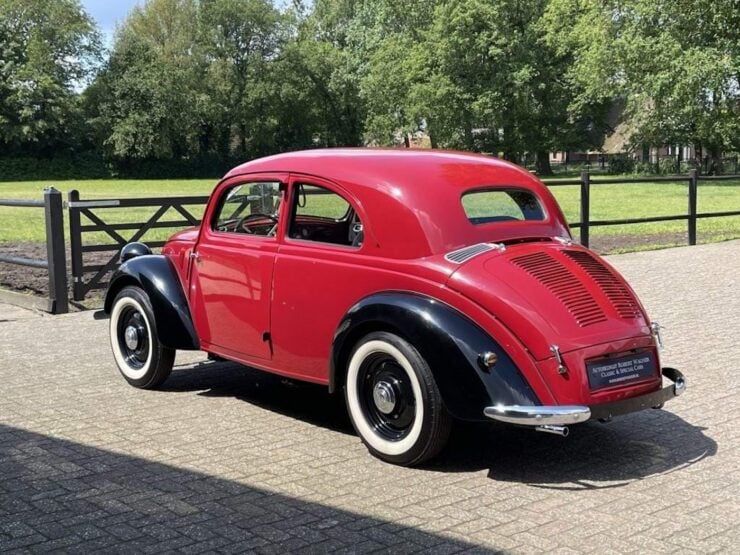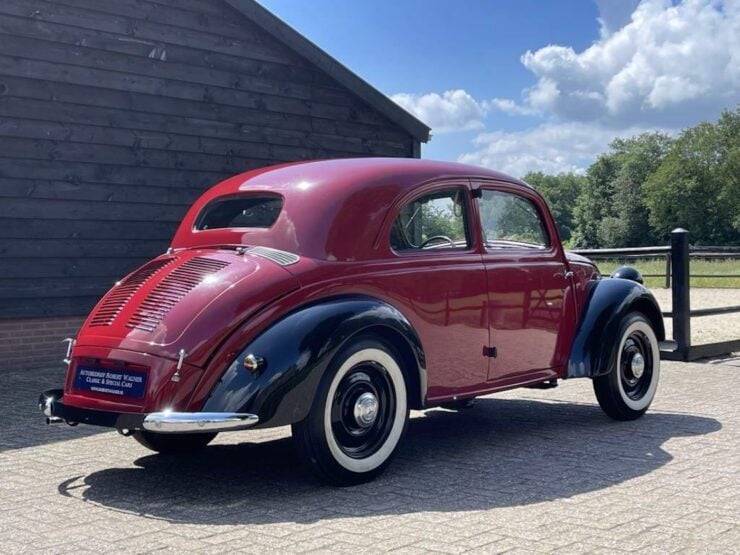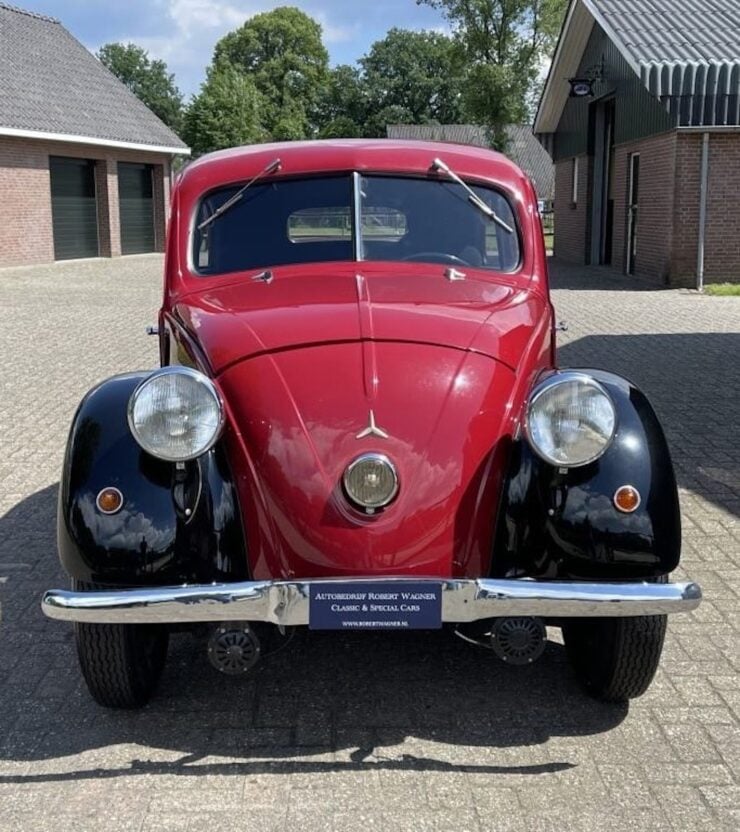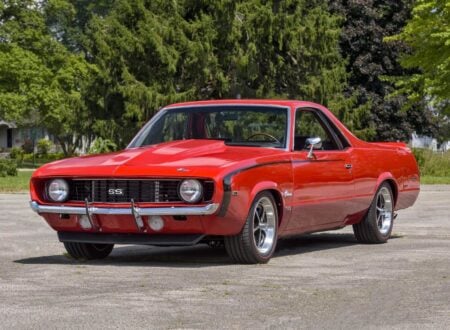This is a rare example of the Mercedes-Benz 170H, otherwise known as “The Benz Beetle.” The car bears more than a passing resemblance to the original Volkswagen– this is perhaps not too surprising as Ferdinand Porsche had been chief engineer at Daimler-Benz in the years before its release.
Unlike the Beetle, which would be built in volumes extending into the tens of millions, just 1,507 examples of the Mercedes-Benz 170H were built in total between 1935 and 1939. Today they’re almost entirely forgotten, and finding a good example that survived WWII is easier said than done.
Fast Facts – The Mercedes-Benz 170H
- The Mercedes-Benz 170H, produced from 1935 to 1939, was a rear-engined compact car with advanced engineering for its time, including independent four-wheel suspension and a 4-speed manual gearbox with semi-automatic overdrive. Only 1,507 units were built, making it a rare and historically significant vehicle.
- Nicknamed “The Benz Beetle,” the 170H shared design similarities with the later Volkswagen Beetle, perhaps reflecting Ferdinand Porsche’s earlier work at Daimler-Benz. Despite its innovations, the 170H struggled with sales due to its high price and unconventional styling compared to traditional front-engined Mercedes models.
- This 1937 Mercedes-Benz 170H features a Red body with Black fenders, chrome accents, whitewall tires, and a distinctive central headlight. It has undergone restoration and comes with documentation and spare parts, making it a well-presented example of this rare pre-WWII model.
- Now offered for sale out of the Netherlands for €64,900 (approximately $68,120 USD) on Car & Classic, the 170H represents a unique opportunity for collectors to own a rare piece of automotive history that is often forgotten today.
The Origins Of The Benz Beetle
In 1923 Dr Ferdinand Porsche would leave Austro-Daimler, where he had been Managing Director, after a series of disagreements about the future direction of automotive development at the company. It would only take a matter of a few months for him to be snapped up by Daimler Motoren Gesellschaft as the company’s new Technical Director.


Porsche already had a long and illustrious career by this time, and he got to work immediately at Daimler. In 1926 Daimler Motoren Gesellschaft and Benz & Cie would merge into Daimler-Benz, with their cars now to be called Mercedes-Benz.
While working for the firm, Porsche came up with a broad range of successful car designs, racing car designs in particular that proved highly successful – perhaps none more so than the dominant Mercedes-Benz SSK.
It seems Porsche’s heart, even at this time, was taken up with the challenge to build a small, lightweight car that would be affordable to the average person. The Daimler-Benz board didn’t agree on the importance of this, and Porsche would leave the company in 1929 – though we do know that he had been working on a series of prototypes for his ideal people’s car before he left.
Just two years later it seems the Daimler-Benz board had a change of heart, and they dusted off the Porsche designs before turning the concept over to Hans Nibel, the new chief engineer of Daimler-Benz, who would develop the Mercedes-Benz 130.
The Mercedes-Benz 130
The Mercedes-Benz 130 was a rear-engined car with independent four-wheel suspension that seemed to take inspiration from Porsche’s designs, as well as designs by Hans Ledwinka of Tatra fame, and Edmund Rumpler’s Tropfenwagen.


The 130 would publicly debut in 1934 but truth be told, it needed more development time. The handling wasn’t as good as it should have been, it was smaller than expected for most Mercedes customers, and it had a significant rear-weight bias due to the aft location of the four-cylinder engine.
The Mercedes-Benz 170H
The Mercedes-Benz 170H would be based on the earlier 130 model, with a slew of improvements to increase power, improve handling, update the styling, and refine the aerodynamics. The rear-engined 170H was sold alongside the front-engined Mercedes-Benz 170V – which was powered by the same inline-four-cylinder 1,697cc unit developing 38 bhp.
The 170H had a backbone-type chassis, and coil spring independent rear suspension with swing axles, with dual transverse leaf springs offering independent front suspension. The car had four-wheel drum brakes, and power was sent to the rear wheels via a 4-speed manual gearbox including a semi-automatic overdrive which didn’t require use of the clutch.
Mercedes claimed the car was capable of 30+ mpg and a top speed of 72 mph, these were solid figures for the time, but the high asking price and the preference Mercedes clientele had for classic front-engined styling did limit sales somewhat.
The “H” in the 170H model name stands for “Heckmotor” or “Rear motor” in English. The front-engined car’s model name contains a “V” which stands for “Vorderseite motor,” or “Front motor” in English.


The 170H appeared in 1935, the same year that the first two Type-60 prototypes of the Volkswagen Type 1 would begin testing, the final production car would be named the “Beetle” due to its shape. Hitler and the Nazi Party had been the driving force behind the Beetle, pumping in significant funds and offering essentially unlimited resources.
Before the outbreak of WWII, the Mercedes-Benz 170H would outsell the VW Beetle, the latter of which was only produced in relatively small numbers due to demand for military supplies taking up an ever-increasing percentage of Germany’s industrial output.
After the war this would all change of course, and a total of 21,529,464 Beetles would be produced, dwarfing the 1,507 examples of the 170H.
In an alternate universe, perhaps there’s a place where the little rear-engined Mercedes became one of the best-selling cars of all time rather than the Beetle, providing the platform for dune buggies like the Meyers Manx as well as Baja Bugs, and providing daily transportation for untold numbers of school teachers, factory workers, line chefs, college students, and California beach bums.
The Mercedes-Benz 170H Shown Here
The car you see here is a 1937 Mercedes-Benz 170H finished in Red with Black fenders, over Black steel wheels with chrome hubcaps and whitewall tires on all four corners.


This 170H has front and rear chrome bumpers as well as that characteristic smaller central headlight that the model was known for. This vehicle has been previously restored, and documentation of this comes with it as well as some boxes of spare parts.
It’s being sold out of the Netherlands on Car & Classic with an asking price of €64,900 or approximately $68,120 USD and you can visit the listing here if you’d like to read more about it or register to bid.















Images courtesy of Car & Classic








